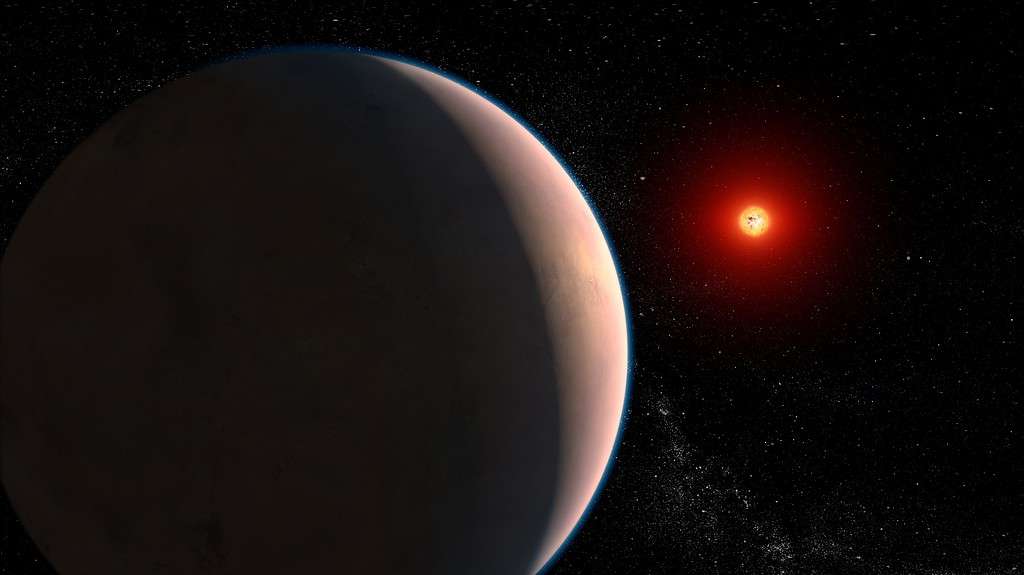
Astronomers using NASA’s James Webb Space Telescope have made an intriguing discovery about a rocky exoplanet known as GJ 486 b, 26 light-years away in the constellation Virgo.
The planet is too close to its star to be in the habitable zone, with a surface temperature of about 800 degrees Fahrenheit (430 degrees Celsius). Despite this, observations using Webb’s Near-Infrared Spectrograph (NIRSpec) show hints of water vapor.
If the water vapor is associated with the planet, it could indicate that the planet has an atmosphere despite its scorching temperature and close proximity to its star, a red dwarf.
“We see a signal, and it’s almost certainly due to water,” said the study lead author Sarah Moran of the University of Arizona in Tucson. “But we can’t tell yet if that water is part of the planet’s atmosphere, meaning the planet has an atmosphere, or if we’re just seeing a water signature coming from the star.”
A wet exoplanet
Red dwarf stars are the most common stars, and rocky exoplanets are most likely to be found orbiting such a star. These stars are cool, meaning that a planet has to hug its parent star in a tight orbit to stay warm enough to potentially host liquid water in the habitable zone.
However, red dwarf stars are also active, particularly when they are young, releasing ultraviolet and X-ray radiation that could destroy planetary atmospheres. This has raised the important question in astronomy of whether a rocky planet could maintain, or reestablish, an atmosphere in such a harsh environment.
“Water vapor in an atmosphere on a hot rocky planet would represent a major breakthrough for exoplanet science. But we must be careful and make sure that the star is not the culprit,” said Kevin Stevenson of the Johns Hopkins University Applied Physics Laboratory in Laurel, Maryland, principal investigator on the program.
GJ 486 b is about 30% larger than Earth and three times as massive, which means it is a rocky world with stronger gravity than here on our planet. It orbits a red dwarf star in just under 1.5 Earth days. It is expected to be tidally locked, with permanent day and night sides, akin to the Moon.
The planet transits its star, crossing right in front of it from our point of view. If it has an atmosphere, then when it transits starlight would filter through those gasses, imprinting fingerprints in the light that allow astronomers to decode its composition through a technique called transmission spectroscopy.
The team observed two transits, each lasting about an hour. They then utilized three different methods to analyze the resulting data.
The results from all three are consistent in that they show a mostly flat spectrum with an intriguing rise at the shortest infrared wavelengths.
The team also ran computer models considering several different molecules, concluding that the signal’s most likely source was water vapor.
This could indicate the presence of an atmosphere on GJ 486 b, but an equally plausible explanation is water vapor from the star. Surprisingly, even in our own Sun, water vapor can sometimes exist in sunspots because these spots are very cool compared to the surrounding surface of the star.
GJ 486 b’s host star is much cooler than the Sun, so even more water vapor would concentrate within its starspots. As a result, it could create a signal that mimics a planetary atmosphere.
“We didn’t observe evidence of the planet crossing any starspots during the transits,” said one of the study’s co-authors, Ryan MacDonald of the University of Michigan in Ann Arbor. “But that doesn’t mean that there aren’t spots elsewhere on the star. And that’s exactly the physical scenario that would imprint this water signal into the data and could wind up looking like a planetary atmosphere.”
Due to the star’s heat and radiation, the presence of a water vapor atmosphere is likely to gradually erode. Therefore, it is likely that any atmosphere would need to be continuously refilled by steam released from the planet’s interior by volcanic activity. If water is found in the atmosphere, more observations are required to estimate its concentration.
The Webb telescope could eventually offer more information about this system. Particularly, the future Webb program will observe the planet’s dayside using the Mid-Infrared Instrument (MIRI).
The hottest spot on the day side is anticipated to be directly beneath the star if the planet has a thin or nonexistent atmosphere. However, if this point were to shift, it would denote the presence of a warm atmosphere.
In the end, observations at shorter infrared wavelengths by the Near-Infrared Imager and Slitless Spectrograph (NIRISS), a different Webb instrument, will be required to distinguish between the planetary atmosphere and starspot scenarios.






